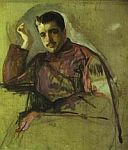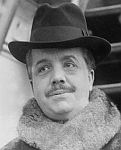Adventures in the Secret Service | Espionage Escapades | Daredevils of the Desert
Young Indy Home
Chapter Overview

Indy once again finds himself undercover, but this time he’s posing as a dancer for the Ballets Russes in Spain. Charged with discrediting some German diplomats, Indy teams up with some fellow spies whose skills, as it turns out, are anything but adequate. Indy is then sent off to Prague where he is ordered to answer a specific phone at a specific place and time. Indy arrives to discover that there is no phone in the designated location. He then encounters the difficulties of dealing with bureaucracies and the never-ending paperwork as he attempts to get a phone installed. In the process of completing his mission, Indy enlists the aid of future writer, Franz Kafka.
Key Topics: | Espionage in World War I; Bureaucracies; Ballet |
Historic People: | Pablo Picasso-- Spanish painter and creator of cubism. |
People and Topics
DescriptorSpanish painter and co-founder of cubism. Often regarded as one of the most well known painters of the twentieth century, Picasso's style forever changed the direction of art. His personal life is equally as fascinating and controversial as his art. BooksKarmel, Pepe. Picasso and the Invention of Cubism. New Haven: Yale University Press, 2003. Richardson, John. A Life of Picasso Volume I: 1881-1906. New York: Random House, 1991. Richardson, John. A Life of Picasso Volume II: 1907-1917. New York: Random House, 1996. Websites |
DescriptorControversial writer whose posthumously published works expressed his feelings on 20th Century man. Many of his works are unfinished and contain parts that stop mid-sentence. Rather than being a hindrance, such occurrences add to the allure and mystery of Kafka's writing. Most famous works include The Metamorphosis, The Trial, and The Castle. BooksBrod, Max. Franz Kafka, A Biography. New York: Schocken Books, 1963. Kafka, Franz. The Trial. Trans. Breon Mitchell. New York: Schocken, 1998. Websites |
DescriptorBallet's origins can be traced back to Renaissance Europe (approx. 1400-1600's). A formal dance technique known for its choreography, which includes mime, acting, and performances to music. Popular ballets include: The Nutcracker, The Sleeping Beauty, and Swan Lake. BooksKodicek, Ann. Diaghilev: Creator of the Ballet Russes. Great Britain: Barbican Art Gallery and Lund Humphries Publishers, 1996. Joseph, Charles M. Stravinsky & Balanchine: A Journey of Invention. New Haven and London: Yale University Press, 2002. Websites |
DescriptorBallet Impresario (financier), patron, and critic, Sergei Diaghilev almost spent his life as a lawyer. Instead, his interest in music and privileged background led him to found one of history's most influential ballet companies, the Ballets Russes. Many of ballet's best choreographers began their careers in the Ballets Russes. Examples include: George Balanchine, Léonide Massine, Bronislava Nijinska, and Vaslav Nijinsky. Diaghilev is also noted for using the musical talents of Igor Stravinsky in many of his ballets. BooksKodicek, Ann. Diaghilev: Creator of the Ballet Russes. Great Britain: Barbican Art Gallery and Lund Humphries Publishers, 1996. Scheijen, Sjeng. Diaghilev: A life. Profile Books, 2009. Websites |
Disclaimer: All resources (including books and websites) provided on indyintheclassroom.com are intended to be used by educators. Indyintheclassroom.com is not responsible for the content on linked websites.
Copyright: All images on Indyintheclassroom.com are used with permission or are in the public domain. Exceptions are noted. For additional information see our Copyright section. |
Documentary Previews
Below you will find information about each documentary that supplements Espionage Escapades.
Impresario: Sergei Diaghilev and the Ballets Russes | Fearless, strong-willed and always a champion of the modern, Sergei Diaghilev discovered a talented group of artists and inspired them to reach new creative heights. Diaghilev wasn't a dancer, choreographer or composer, but he was the impresario, and the show couldn't go on without him. Together, they shaped ballet into a new art form, leaving an indelible mark on art for the 20th Century. Produced and written by David O'Dell. Running Time: (0:28:13) |
Ballet: The Art of Dance | Beautiful and effortless, ballet is one of the world's most elegant art forms -- the human body as poetry in motion. Achieving and maintaining the artful illusion of ballet is all-important; but it's just that, an illusion meant to appear effortless. What kind of commitment does it take for dancers to master the unmistakable yet rigorous style of ballet? And where does that commitment lead young dancers in their pursuit of excellence? Produced and written by David O'Dell. Running Time: (0:32:16) |
Franz Kafka's Dark Truth | Franz Kafka had made his living as an attorney in an insurance company, where he'd eked out an obscure and unexceptional life. But when the lawyer put pen to paper, the writer conjured a disturbing world where the absurd was commonplace and reality a nightmare. Since his death, Franz Kafka's work has become enormously influential. It remains unrivaled for its intensity, modernity and prescience. Produced and written by Adam Sternberg. Running Time: (0:31:21)
|
Disclaimer: All resources (including books and websites) provided on indyintheclassroom.com are intended to be used by educators. Indyintheclassroom.com is not responsible for the content on linked websites.
Copyright: All images on Indyintheclassroom.com are used with permission or are in the public domain. Exceptions are noted. For additional information see our Copyright section. |
Indy Connections: Espionage Escapades
Below are current event articles that relate to events, topics, and people found in Espionage Escapades.
The Most Loved and Hated Novel About World War I
Smithsonian.com
6/16/2015
On December 5, 1930, just over 12 years after the end of World War I, German moviegoers flocked to Berlin’s Mozart Hall to see one of Hollywood’s latest films. But during the movie, a cadre of 150 Nazi Brownshirts, nearly all too young to have fought in World War I, were led into the theater by propagandist Joseph Goebbels. Spewing anti-Semitic invective at the screen, they repeatedly shouted “Judenfilm!” as they tossed stink bombs from the balcony, threw sneezing powder in the air, and released white mice into the theater. A somewhat shocking turn of events, considering the movie was the highly anticipated adaptation of countryman Erich Maria Remarque’s novel All Quiet on the Western Front, the blockbuster novel that had transfixed the nation months earlier.
Sunken Wrecks Of Epic WWI Naval Battle Revealed
news.sky.com
6/16/2015
They show the battered wrecks of several of the 25 warships - 14 of them British - that were blown up during the Battle of Jutland on 31 May, 1916. Among them is HMS Invincible which was torn apart by a German shell, killing more than 1,000 sailors. HMS Defence and HMS Queen Mary were also scanned during the survey.
World War One time capsule discovered in Germany
telegraph.co.uk
11/21/2014
A hundred years after the outbreak of the First World War, builders renovating a historic castle in Germany’s Ruhr valley have found a time capsule that appears to have been left in memory of soldiers who died in the conflict.
First World War centenary: how the events of August 2 1914 unfolded
telegraph.co.uk
8/2/2014
Britain went to war on August 4 1914. In the second part of a four-day series, we document the dramatic events leading up to the declaration of war as they happened, hour-by-hour.
For men used to mining - fighting in trenches was seen as an escape FROM HELL
express.co.uk
6/1/2014
These days, however, Big Pit digs tourism, not coal; the party descending into the earth are American visitors. There are no working deep-mines remaining in South Wales; already in decline, the area's coalfield was annihilated in the wake of the 1984-5 Miners' Strike, the names of the closed collieries to toll like funeral bells. Mardy. Tower. Deep Navigation. Markham. Lady Windsor. How black was my valley a century ago, on the eve of the Great War, when there were a dozen collieries within sight, and another 600 coal mines across South Wales, employing 232,000 men, who hewed 57 million tons a year, a fifth of the entire output of the United Kingdom. The very earth vibrated to the metronomic percussion of thousands of subterranean men wielding the pick. Coal for the Navy. Coal for industry. Coal for locomotives. Coal for homes.
The ten men who shaped the road to war
independent.ie
5/10/2014
1 HORATIO KITCHENER As the first British troops marched whistling off to the front in autumn 1914 the cliche of the hour was: "It'll be all over by Christmas." An experienced campaigner on three continents, Horatio Kitchener from Ballylongford, Co Kerry, knew it would be a long haul. As Secretary of State for War he put together the largest volunteer army the world had ever seen, and put industrial production on an efficient war footing.
Help Transcribe Diaries From World War I
Smithsonian.com
3/18/2014
The National Archives currently has in its collection 1.5 million pages of handwritten diaries kept by soldiers of World War I. They're some of the most requested documents in the National Archives reading room, but until now have been accessible only to anyone who's made the trip to D.C. But now the archivisits are working to put them online, and you can help them. The project is called Operation War Diary, and it comes from a partnership between the National Archives, the citizen science initiative Zooniverse and the Imperial War Museum in the UK. The diaries have all been scanned and posted online for citizen historians to look at and transcribe. According to the project: "The war diaries contain a wealth of information of far greater interest than the army could ever have predicted. They provide unrivalled insight into daily events on the front line, and are full of fascinating detail about the decisions that were made and the activities that resulted from them."
World War One: 10 interpretations of who started WW1
bbc.com
2/11/2014
No one nation deserves all responsibility for the outbreak of war, but Germany seems to me to deserve most. It alone had power to halt the descent to disaster at any time in July 1914 by withdrawing its "blank cheque" which offered support to Austria for its invasion of Serbia. I'm afraid I am unconvinced by the argument that Serbia was a rogue state which deserved its nemesis at Austria's hands. And I do not believe Russia wanted a European war in 1914 - its leaders knew that it would have been in a far stronger position to fight two years later, having completed its rearmament programme.
World War One: The circus animals that helped Britain
bbc.com
11/10/2013
On the cobbled streets of industrial Sheffield an Indian elephant dutifully lumbered along. Her task was important - she had to cart munitions, machines and scrap metal around the city, a job previously done by three horses taken off to war. Lizzie - as she was known - was used to performing tricks as part of a travelling menagerie. But with the outbreak of World War One she was conscripted to help with heavy labour, fitted with a harness and sent to work at a scrap metal merchants.
German Subs: Sunken WWI U-Boats a Bonanza for Historians
abcnew.com
6/21/2013
British archaeologists recently discovered more than 40 German U-boats sunk during World War I off the coast of England. Now they are in a race against time to learn the secrets hidden in their watery graves. On the old game show "What's My Line?" Briton Mark Dunkley might have been described with the following words: "He does what many adventurers around the world can only dream of doing." Dunkley is an underwater archeologist who dives for lost treasures. His most recent discoveries were anything if not eerie.
Disclaimer: All resources (including books and websites) provided on indyintheclassroom.com are intended to be used by educators. Indyintheclassroom.com is not responsible for the content on linked websites.
Copyright: All images on Indyintheclassroom.com are used with permission or are in the public domain. Exceptions are noted. For additional information see our Copyright section. |
Suggested Lessons
Adventures in the Secret Service | Espionage Escapades | Daredevils of the Desert
Young Indy Home




